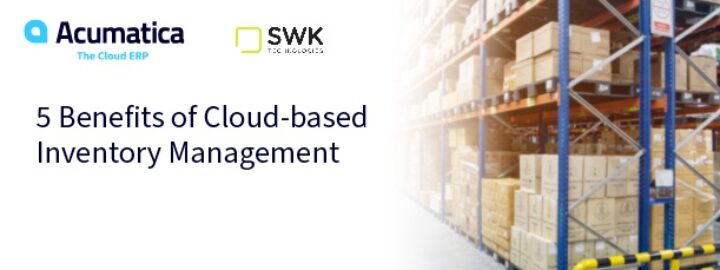
Inventory Turnover Ratio: Definition & Calculation
For retailers, distributors, and manufacturers, inventory management is key to operational success. Your inventory is your most important asset, and, to meet customer demand, while avoiding under- and overstocking, you have to think about many variables. How many units of Item A are available? Where is Item B located? What’s the status of Item C?
Calculating your Inventory Turnover Ratio is a vital way to measure inventory performance and efficiency.
Today, we’ll define Inventory Turnover Ratio, explain the steps and formulas used to calculate it, and explore how you can improve inventory practices with technology.
What is an Inventory Turnover Ratio?
Inventory turnover is the cyclical process of purchasing an inventory item, selling that item, and replacing it with more of the same item to sell again.
For instance, in a grocery store setting, you buy a shipment of orange juice; consumers purchase that orange juice from you; and then you buy another orange juice shipment to restock.
This cycle may sound simple, but real-world complexity, from shifting customer demand to cross-border logistics, can make it challenging to manage. English craft beer distributor Cave Direct (more about them later) was up against these challenges while trying to manage inventory with spreadsheets that could be 300 pages long. Laurence Smale, Cave Direct’s Head of Sales, says “For us, it was just a nightmare trying to keep on top of it from a sales perspective because you never knew what’s coming in. We have as many as 50 new craft brews arriving each week and it was difficult for the sales team to know which warehouse held that stock or whether it was already sold out.”
And that’s just one of many reasons why calculating your Inventory Turnover Ratio is important. Let’s first look at how to work it out manually—and then we’ll revisit Cave Direct to see how they solved their inventory management challenges.
Your Inventory Turnover Ratio shows how many times, over a given period, your business has completed an inventory turnover cycle of selling and restocking. It reveals how efficiently you use your inventory. According to Investopedia, “A relatively low inventory turnover ratio may be a sign of weak sales or excess inventory, while a higher ratio signals strong sales but may also indicate inadequate inventory stocking.” So, your Inventory Turnover Ratio can help you understand how to make stocking plans that balance customer demand with overhead costs and your organization’s needs.
But determining whether a high or low Inventory Turnover Ratio is good or bad depends on your industry. Businesses carrying items that should move quickly—like grocery stores, florists, etc.—should have a higher ratio because their inventory is perishable and must be bought, used, and replaced quickly. Other businesses—like jewelers, furniture stores, vehicle dealerships, etc.—should have a lower ratio because their inventory items are durable, investment products that people buy to keep.
How to Calculate Your Inventory Turnover Ratio
Calculating your Inventory Turnover Ratio requires several steps. Here is the main formula:
COGS / Average Value of Inventory = Inventory Turnover Ratio
COGS, which stands for Cost of Goods Sold, is a line item on your income statement that shows the direct costs of procuring or producing the goods you sell—for example, material and labor expenses. Indirect costs—like distribution, overhead, and sales employee expenses—are not included.
Average Value of Inventory is the mean monetary value of your inventory during the specific timeframe you’ve chosen to measure (e.g., month, quarter, or year). And you calculate it as you would the mean or average of any two numbers: by adding the Beginning Inventory Value to the Ending Inventory Value and dividing the sum by 2.
(Beginning Inventory Value + Ending Inventory Value) / 2 = Average Value of Inventory
While the Beginning Inventory Value should be the same as the Ending Inventory Value for the previous period, it’s important to know how to calculate it separately, so you can double-check its accuracy. You can calculate Beginning Inventory Value with this formula:
COGS + Ending Inventory Value from Previous Period – Value of New Inventory Bought During Previous Period = Beginning Inventory Value
With the Beginning Inventory Value confirmed, you can use it to calculate the Ending Inventory Value like this:
Beginning Inventory of Current Period + Net Purchases During Current Period – COGS = Ending Inventory Value
The Net Purchases variable represents the gross monetary value of new inventory purchased during the chosen period, minus discounts, returns, and allowances.
Now, let’s put all these steps together to calculate an Inventory Turnover Ratio.
Inventory Turnover Ratio Example
Let’s say you want to calculate your Inventory Turnover Ratio for April 2025.
You’ll complete the formulas above in this order:
- Beginning Inventory Value: COGS + Ending Inventory Value from Previous Period – Value of New Inventory Bought During Previous Period = Beginning Inventory Value
- Ending Inventory Value: Beginning Inventory of Current Period + Net Purchases During Current Period – COGS = Ending Inventory Value
- Average Value of Inventory: (Beginning Inventory Value + Ending Inventory Value) / 2 = Average Value of Inventory
- Inventory Turnover Ratio: COGS / Average Value of Inventory = Inventory Turnover Ratio
Let’s say that your COGS for March 2025 was $50,000, your Ending Inventory Value was $40,000, and the value of your New Inventory Bought was $40,000. That means your Beginning Inventory Value is $50,000 (the same as the Ending Inventory Value for March.)
$50,000 + $40,000 – $40,000 = $50,000
If your Beginning Inventory Value was $50,000, your Net Purchases for April were $75,000, and your COGS was $80,000, then your Ending Inventory Value for April was $45,000.
$50,000 + $75,000 – $80,000 = $45,000
Using the Beginning and Ending Inventory Values, your Average Value of Inventory was $47,500.
($50,000 + $45,000) / 2 = $47,500
And, using your April COGS and Average Value of Inventory numbers, your Inventory Turnover Ratio is 1.7.
$80,000 / $47,500 = 1.7
This means, for April 2025, you completed almost two full inventory turnover cycles. And again, whether that ratio is good or not depends entirely on your industry and on the specific conditions in which your business operates.
But, if you find that your Inventory Turnover Ratio is not what it should be—and if you, like Cave Direct, don’t want to manually calculate it with all these steps, every time—what can you do? The right technology can help.
Improving and Automating Inventory Turnover
While your Inventory Turnover Ratio is a critical marker of your business’s health, that number alone cannot give you fully actionable insights. It can show that there is a problem or that you’re experiencing increased success, but it can’t tell you what the problem is or what has contributed to your success. You need to regularly monitor and optimize your inventory processes on every level to continually improve operational efficiency and financial health.
As we’ve seen above, even just calculating Inventory Turnover Ratio requires much thought and multiple steps. On a bigger scale, ensuring efficient inventory processes that optimize both stock levels and sales performance is even more complicated—and nearly impossible if you’re trying to do it all manually. But with the help of technology designed for the task, such as an Enterprise Resource Planning (ERP) solution with a built-in Inventory Management application, you’ll have access to specialized tools that automate inventory turnover calculations, on top of streamlining item management, quality traceability, replenishment, and more.
Other ERP capabilities that help businesses manage their inventories include:
-
- Demand forecasting and Just-in-Time (JIT) features, so you can order items based on projected demand and production schedules, eliminating overstocking, preventing waste, and lowering storage costs.
- Data for SKU (Stock Keeping Unit) rationalization, so you can see the profitability, costs, and customer demand for certain SKUs and determine whether to keep, expand, or reduce inventory for that item.
- Dead Stock Reports, which show items that should be phased out because customers are no longer buying them, and they are taking up valuable warehouse space.
- ABC Codes that categorize inventory according to its importance to the business: A for high-value items that significantly contribute to revenue, B for mid-range, moderate-value products, and C for low-value, less critical items. ABC codes help businesses prioritize stock management, improve purchasing strategies, and better predict reordering schedules based on demand.
Relying on connected, modern technology for tracking, monitoring, and analyzing inventory turnover helps improve efficiency, increase cash flow, and, ultimately, boost profitability.
Inventory Management Success with Acumatica
Acumatica Cloud ERP and its Inventory Management solution empower users to control inventory across locations, automate orders, streamline workflows, and track items (and costs) from a single, centralized solution. The benefits? Increased inventory turns, improved accuracy, and reduced stock-out situations; insights into low and dead stock items; and the ability to analyze profitability by item and product class or family.
Colin Gilhespy, Co-Owner and Managing Director of Acumatica customer Cave Direct, witnessed these benefits and more firsthand. By providing full inventory transparency, Acumatica has made a world of difference in the company’s ability to forecast demand, manage inventory turnover, and know what products they need to stock or phase out.
Before Acumatica, “Turnover was quite a lot less, but we always knew there was potential in our business,” says Gilhespy. “And to fulfill that potential, we needed something that would manage our stock better.”
“Having that stock control,” he continues, “is incredible. That’s put us at the forefront, especially in the craft beer industry. Now we can track it all; everything we do is in Acumatica. Whatever information we want, we can have it at the click of a button, and that’s the key to our success. We know what’s in each warehouse and when goods are sold.”
With Acumatica, businesses like Cave Direct gain inventory management simplicity, visibility, and efficiency and enjoy automated inventory turnover ratio calculations that provide the insights they need to thrive in today’s digital, fast-paced world.
 Canada (English)
Canada (English)
 Colombia
Colombia
 Caribbean and Puerto Rico
Caribbean and Puerto Rico
 Ecuador
Ecuador
 India
India
 Indonesia
Indonesia
 Ireland
Ireland
 Malaysia
Malaysia
 Mexico
Mexico
 Panama
Panama
 Peru
Peru
 Philippines
Philippines
 Singapore
Singapore
 South Africa
South Africa
 Sri Lanka
Sri Lanka
 Thailand
Thailand
 United Kingdom
United Kingdom
 United States
United States













